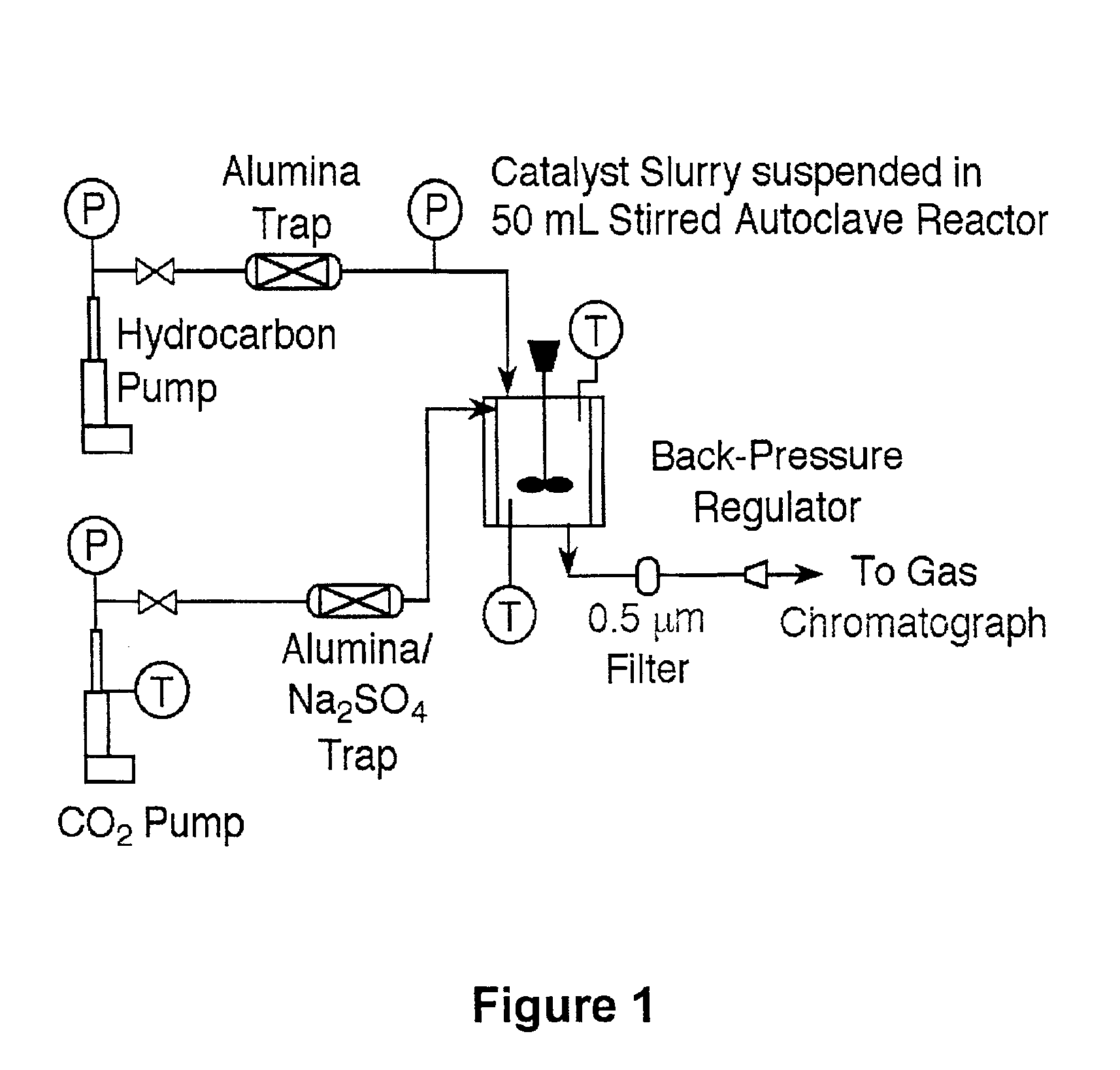Pressure-tuned solid catalyzed heterogeneous chemical reactions
a heterogeneous chemical reaction and pressure-tuned technology, applied in metal/metal-oxide/metal-hydroxide catalysts, combustible gas purification/modification, bulk chemical production, etc., can solve the problem of inability to achieve gas phase isobutane/butene alkylation, and the production of desirable c8 alkylates is significantly increased
- Summary
- Abstract
- Description
- Claims
- Application Information
AI Technical Summary
Benefits of technology
Problems solved by technology
Method used
Image
Examples
example 1
[0030]In this example, a series of supercritical condition alkylation reactions of butene and isoparaffin with a molar excess of carbon dioxide were carried out using a preferred catalyst in order to demonstrate temporal and selectivity profiles for the reactions.
[0031]The reactor schematic is shown in FIG. 1. Continuous stirred tank reactor (CSTR) experiments were conducted in a 50 mL Microclave from Autoclave Engineers, rated to 344 bar and 616 K. Catalyst particles were suspended in the reaction mixture by an impeller operating at 1200 RPM. Fixed-bed reactor experiments were conducted in a 1″ I.D. stainless steel tubular reactor from Autoclave Engineers, rated to 1110 bar at 700 K. The catalyst bed was supported on both ends with glass wool (Alltech) and stainless steel mesh screens, which were confirmed to be inert under reaction conditions.
[0032]The catalysts investigated were characterized before and after use. Unsupported Nafion® polymer beads and 13% Nafion® on silica (SAC-1...
example 2
[0040]In order to investigate the effect of pressure-tuning on catalyst activity and product selectivity, a series of separate alkylation experiments was carried out at supercritical pressures between 80 and 167 bar. All other conditions were identical: 368 K, 0.05 h−1, I / O=5, 2.4 fold excess CO2, 1200 rpm. Each run was performed for at least 24 hours, and the steady-state averages (between 10 hours and end-of-run) for conversion and selectivity are shown in FIG. 3. The steady butene conversion (˜80%) is relatively independent of pressure. At the highest supercritical pressure (167 bar), the alkylate selectivity is lowest at 7%, and the overall C8 selectivity is approximately 30%. As the pressure is decreased towards the critical pressure, the observed alkylate selectivity increases nearly fourfold. The results are interpreted as follows: at near-supercritical pressures, heavier compounds (C12+) are preferentially retained in the macropores. This in situ separation enhances the C8 s...
example 3
[0049]In this example a multiple-cycle alkylation experiment was performed, with successive alkylation and catalyst regeneration cycles.
[0050]10 g of silica-supported Nafion® acid catalyst (SAC-13, provided by Engelhard Corp.) was loaded into the reactor, and pretreated in dry nitrogen at 423 K and atmospheric pressure for 6 hours.
[0051]The reactor was a 50 mL stirred vessel (Autoclave Engineers) with an electrical heating jacket controlled by a CAMILE data acquisition and control system. The catalyst particles, between 62 and 105 μm, were suspended in the fluid by intense stirring at 1200 RPM. The reactor was purged and pressurized with carbon dioxide at 368 K and 87 bar. The isobutane / 1-butene mixture was premixed to a molar ratio of 5:1, and pumped from an ISCO syringe pump. This feed was pumped at 5.4 mL / hr through a 6 g bed of neutral alumina, to adsorb any organic peroxides (which are known to be prolific coke precursors). Carbon dioxide was pumped at 6.6 mL / hr from an ISCO sy...
PUM
| Property | Measurement | Unit |
|---|---|---|
| Tc | aaaaa | aaaaa |
| pressure | aaaaa | aaaaa |
| pressure | aaaaa | aaaaa |
Abstract
Description
Claims
Application Information
 Login to View More
Login to View More - R&D
- Intellectual Property
- Life Sciences
- Materials
- Tech Scout
- Unparalleled Data Quality
- Higher Quality Content
- 60% Fewer Hallucinations
Browse by: Latest US Patents, China's latest patents, Technical Efficacy Thesaurus, Application Domain, Technology Topic, Popular Technical Reports.
© 2025 PatSnap. All rights reserved.Legal|Privacy policy|Modern Slavery Act Transparency Statement|Sitemap|About US| Contact US: help@patsnap.com



